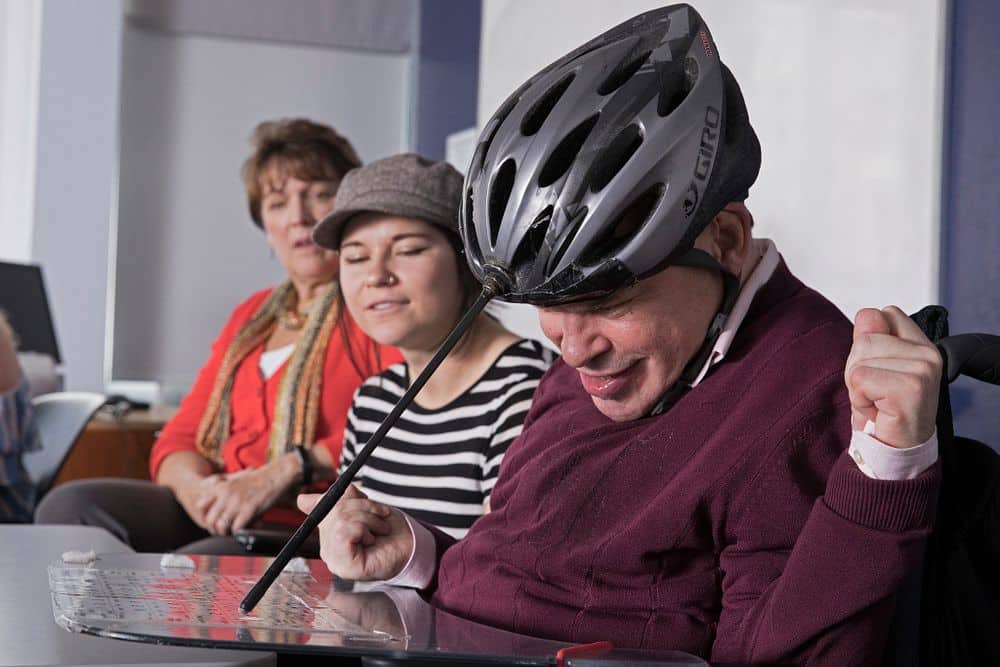For the third year in a row, NAU is kicking off Disability Pride and Heritage Month with the Not Inspiration Pørn Film Festival, an opportunity for all community members to explore the diverse, authentic lived experiences of people with disabilities. It’s the brainchild of John Schaffer, the academic program coordinator and faculty member for the Disability Studies minor. Prior to the third annual film festival, he talked to The NAU Review about the types of films being shown, including the world premiere of two films made about NAU community members, and the importance to have conversations about the representation of people with disability in popular media.
Learn more about the film festival, which takes place from 6-8:30 p.m. Saturday in the Cline Library Assembly Hall. It is open and free to all.
The Commission on Disability Access and Design also has several events planned throughout October, including sensory crafts and learning more about accessibility at NAU. The keynote event takes places Oct. 8, when the NAU community is invited to celebrate Judy Heumann, the mother of the disability rights movements. Register for that event online.
See the full list of CDAD events in October.

How did the film festival get started?
The Institute for Human Development received a grant to help promote the Disability Studies minor, in part, because they had seen a film I made about NAU instructor Matthew Wangeman. I was appointed the chair of a committee tasked with figuring out how to spend the money. At the first meeting, I suggested we host a disability film festival because movies can be a great way to engage people around the issues we talk about in our DS program and also because of my love of filmmaking. The committee gave their unanimous approval, so we started right away to plan our first festival.
Where did the “Not Inspiration Porn” theme come from?
The term “inspiration porn” was coined by Australian disability rights activist Stella Young in 2014. In our Introduction to Disability Studies class, we watch her TED talk on the subject and then have a great discussion around the topic. When our committee was discussing our plans for the film festival, I often mentioned that I wanted to make sure we didn’t show films that felt like inspiration porn but were more authentic and true stories of people with disabilities. One day as I was reviewing films for the festival, I finished a film and thought, this film is definitely not inspiration porn. It then occurred to me that we should name our festival that. Knowing that the use of the word “porn” was provocative, I was really scared our committee wouldn’t like it. To my surprise, everyone liked it! We did have extensive conversations about it and even revisited the topic with this third festival, but we feel it’s not only an appropriate and accurate title, it also stimulates conversations because we define it on our festival flier. The first year, we did receive some pushback and some of our fliers were taken down, but we came up with the idea to use the “ø” in pørn and since then, it seems to be more acceptable.
Why is using people with disabilities as inspiration porn harmful?
“Inspiration porn” is really about exploiting people with disabilities for the benefit of non-disabled people. The classic examples that Stella shared were memes that showed people with disabilities with the words, “What’s your excuse?” The message is if someone as weak or pathetic as a person with a disability can do it, then you, non-disabled people, should be able to do it too. Some of the memes are particularly bad because they don’t even show a person with a disability doing anything even mildly remarkable. The harm is that is sets low expectations for people with disabilities and reinforces the ableist perspective that people with disabilities are less capable. These kinds of portrayals are not meant to inspire people with disabilities to do great things, but rather, they are to inspire nondisabled people to make sure they don’t fall behind the disabled.
What do you want people who attend the festival to understand about people with disabilities and their representation in media?
I want the audience to understand that the disability community is made of a diverse group of people with different backgrounds, identities and disabilities and that they are just trying to live their best life like everyone else. For too long, not only was inspiration porn a problem with representation, but the larger issue was that films only showed people with disabilities in roles that elicited pity, roles that had them overcoming their disability or roles that portrayed them as superheroes. They weren’t authentic to the real lived experience of most people with disabilities. If you want to hear more about how these representations are harmful, you should take one of our disability studies classes!
What’s special about this year’s festival?
This year’s festival is extra special because we will be premiering two films about individuals within our NAU community. The first film, “A Blind Man Walks Into a Classroom,” features Chris Lanterman, a blind professor in the College of Education. Chris is well-known around campus not only for his great teaching skills but also because of his long involvement with the Commission on Disability Access and Design. The second film is a sequel of sorts to the film that helped get the funding for the festival. It features Matthew Wangeman, an instructor in our program who came up with the idea for the minor in disability way back in 2008. His first film, “My Dad Matthew,” premiered in the Cline Library Assembly Hall in 2016 to a standing-room-only crowd and we hope this year’s film, “My boss Friend Matthew,” will have a similar audience. We also have an NAU student-produced film, “Obsessives Compulsive Delight,” made by Allison Stenger. She is a graduate student in the Eds School Psychology program. Besides these local films, we are screening several award-winning shorts, both documentary and narrative, from throughout the world. The selection of films this year celebrate disability pride, expose the societal and physical barriers many people with disabilities face, shows them in intimate relationships, shows them grieving the loss of a parent and shows them being human in ways that they want to be portrayed.



